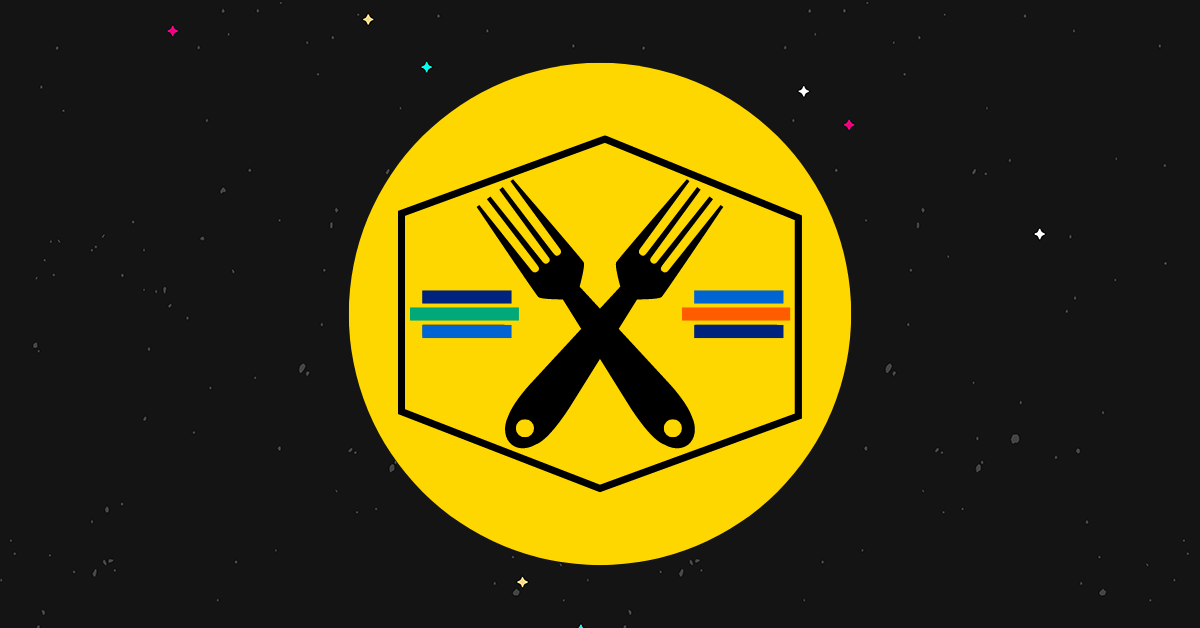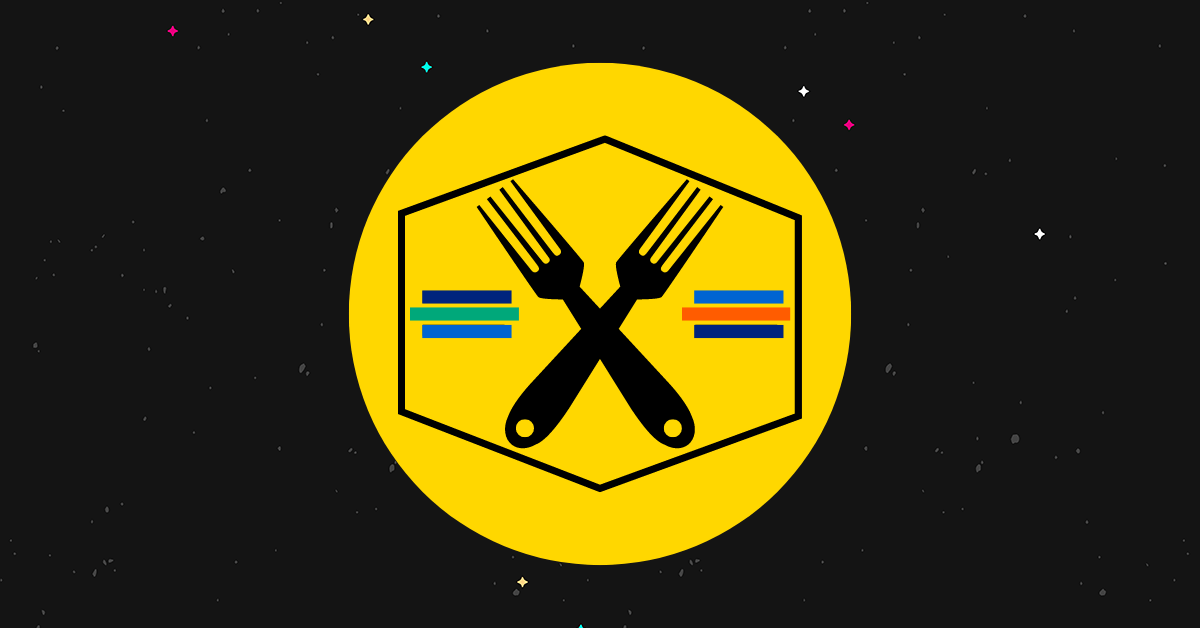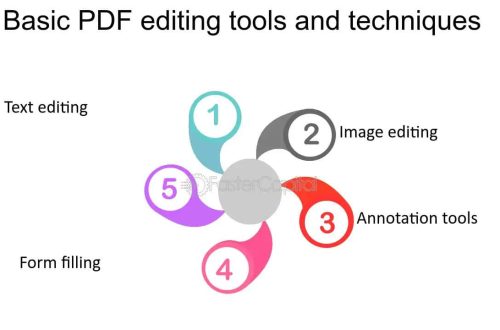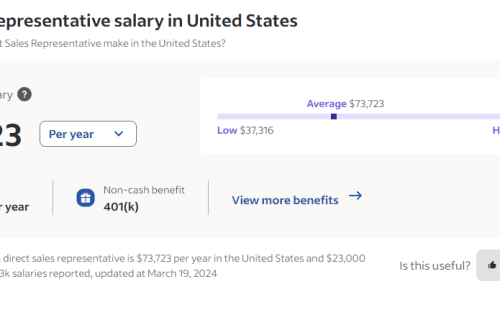Are you interested in starting your own food blog and sharing your recipes with the world?
Food blogging has become one of the most popular forms of blogging, and there are plenty of blogs out there that have figured out the industry well enough to earn a profit (and then some).
That’s why in this post, we’ve listed the best food blog examples to use as inspiration for your own blog.
Below, you’ll find a handful of successful blogs in this niche as well key takeaways on each blog’s approach to content, social, and monetization.
And plenty of delicious foods you can make at home!
We used the following tools to uncover metrics and other details about each blog:
- MozBar – Domain authority (DA).
- Similarweb – Traffic in visits per month.
- Pingdom – Load time. Tested from Washington, D.C. server.
- Wappalyzer – Content management system (CMS).
- Source Code – We used this functionality in Chrome to reveal recipe card plugins.
The list is arranged from highest to lowest traffic. Let’s get into it.
The best food blog examples
- Cookie and Kate – A charming vegetarian, whole foods-based blog about a girl and her dog.
- Minimalist Baker – A collection of simple vegan (and now animal-based) recipes that use one bowl and take 30 minutes or less.
- Pinch of Yum – An influential food blog (and lifestyle blog) that features a little bit of everything as far as recipes go.
- Chocolate Covered Katie – One of the most popular sweet-themed food blogs on the web.
- Iowa Girl Eats – A great food blog for gluten-free recipes.
1. Cookie and Kate
DA: 70 | Traffic: 10 million+ per month | Load Time: 771ms | CMS: WordPress
At over 10 million visits per month, Cookie and Kate is not just one of the most popular vegetarian food blogs on the web—they’re also one of the most popular food blogs, period.
Kate started the blog in 2010 and named it after the dog she adopted a year earlier: Cookie.
Along with vegetarian dishes that use plant-based ingredients in place of meat, Kate also believes in eating whole foods, so the blog is full of healthy recipes made from scratch.
The website even uses the same, personal-blog web design style blogs have been using for decades (content on the left, sidebar on the right, even on the homepage), which is a charming quality for a blog as successful as Cookie and Kate.
Content
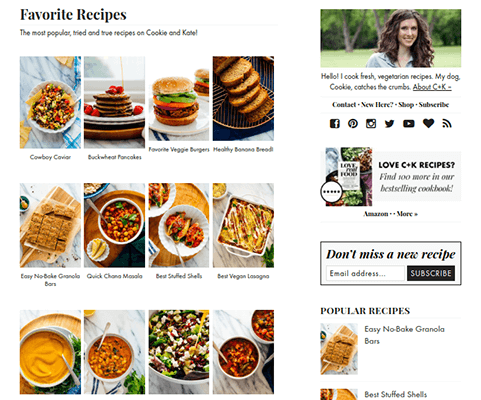
Cookie and Kate publishes new blog posts a few times a month.
Its primary categories are based on courses: Breakfast, Salad, Soup, Dinners and Desserts.
There’s also a category named Favorites, which helps readers keep track of Kate’s favorite dishes.
However, if you hover over the All Recipes menu item, you’ll find an even greater breakdown of the site’s content, including menu items named Course, Cuisine, Diet, Everyday, Ingredient and Season.
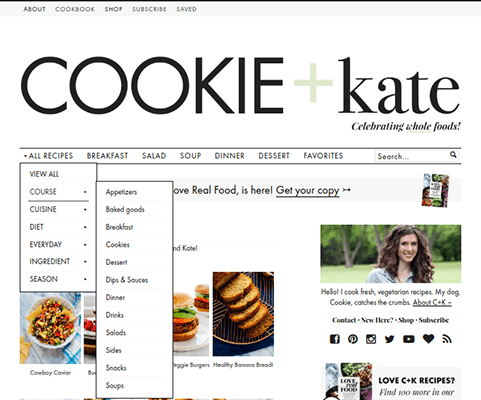
Along with healthy vegetarian recipes, the blog also publishes list posts filled with past recipes, such as “33 Fresh Super Bowl Recipes.”
Recipe pages are filled with a mixture of text and photos taken throughout the preparation process of the recipe.
Kate uses a Nikon Z6 with a Nikkor Z 50mm lens.
Text explains Kate’s idea behind the recipe and provides a detailed breakdown of each step in the preparation process.
Recipe and nutrition cards close out the recipe. Kate uses the Tasty Recipes recipe card WordPress plugin, which allows readers to print recipes and scale them for larger servings.
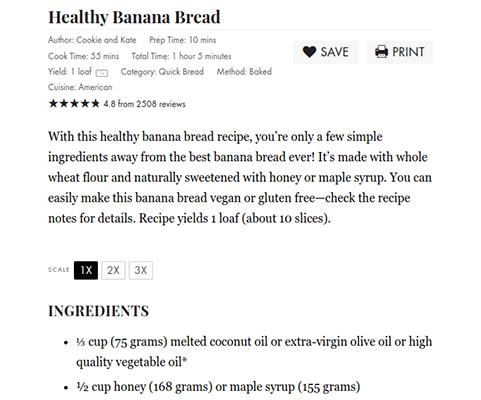
Kate is also partners with Relish, which allows her readers to save recipes and add ingredients to a shopping list for nearby grocery stores in one click.
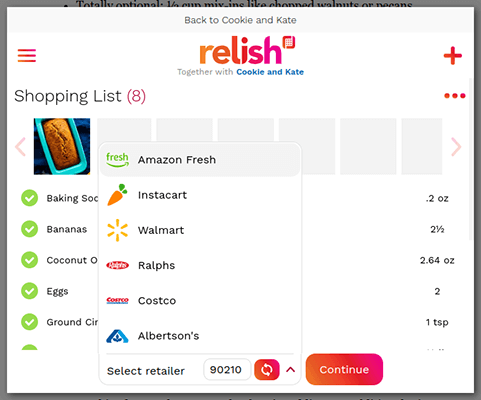
Income streams
Cookie and Kate uses ads from the AdThrive ad network, including sticky ads in the sidebar and at the bottom of the viewport and fixed ads throughout blog posts.
Kate also uses affiliate links from Amazon for certain ingredients, but most posts don’t have any affiliate links.
She uses an affiliate shop on Amazon.com instead, which you can find in the top bar navigation menu on the Cookie and Kate website.
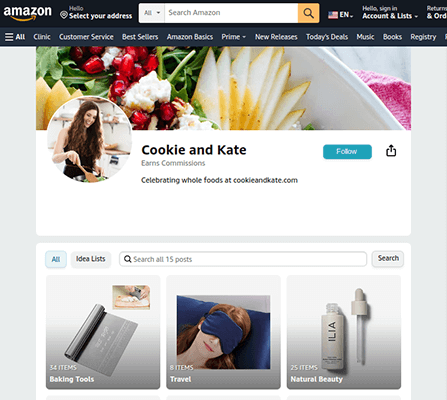
A major source of income for the blog is Kate’s cookbook Love Real Food, which was #2 in the Vegetarian Cooking book category on Amazon at the time this article was written.
Kate advertises this book on every page across her website. It has a 4.7 star rating from over 5,100 reviews.
Social media activity
Cookie and Kate is active on Facebook, Pinterest, Instagram, Twitter and YouTube but receives most of their engagements from Facebook, Instagram and Pinterest.
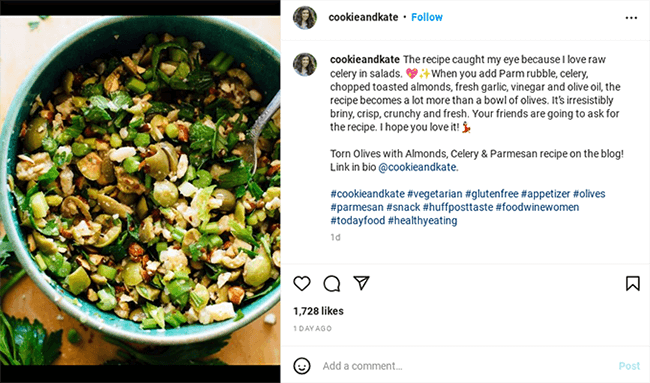
The blog receives a few dozen likes on each Facebook post and hundreds of likes per post on Instagram.
Kate also asks her readers to use the #cookieandkate hashtag on Instagram when they make her recipes. The hashtag has over 27,000 posts.
2. Minimalist Baker
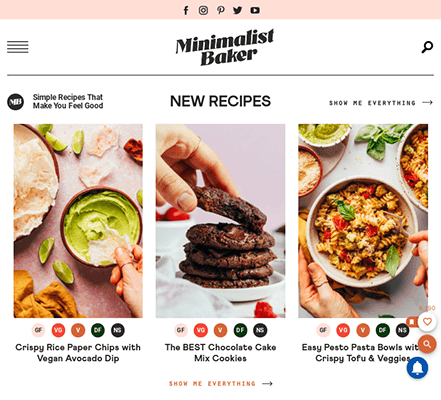
DA: 79 | Traffic: 5.5 million+ per month | Load Time: 1.19s | CMS: WordPress
Minimalist Baker was founded in 2012 by husband-and-wife team Dana and John Shultz.
Originally, Dana was the chef and food writer, which included food photography duties. John handled the design and technical aspects of the website.
Now, Dana works as creative director, John manages the business attached to the blog (and technical aspects related to it), and the rest is maintained by a team.
The blog carved out its niche early on: vegan recipes made in one bowl with 10 ingredients or less and at most 30 minutes.
They expanded their content when they expanded their team, however, so the blog now includes recipes that use egg, dairy and meat-based ingredients.
Content
Minimalist Baker publishes new posts to the blog regularly, usually a new recipe or a list post featuring a collection of past recipes.
Each recipe has a set of labels that depict dietary restrictions, such as DF for Dairy Free, V for Vegetarian, VG for Vegan or GF for Gluten Free.
Minimalist Baker allows you to switch between them and a handful of other filters on a recipe index page, a tool food blogs sometimes use to make it easier for readers to find recipes that suit their tastes and dietary restrictions.
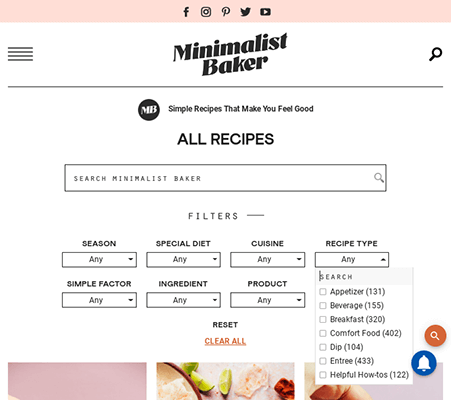
The blog uses a custom child theme for the Genesis WordPress theme these days, but you can easily create your own recipe index page with a food blog theme, such as the Foodie Pro child theme for Genesis.
The blog doesn’t add much text to posts as other food blogs do. They choose to pad posts with large images instead, which they take with a Canon 5D Mark III camera with a Canon EF 50mm lens.
Other than that, recipe pages feature a recipe card made with the WP Recipe Maker WordPress plugin.
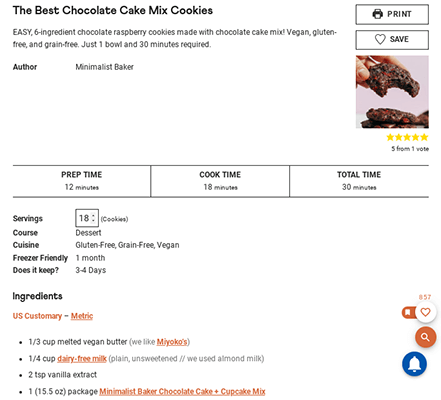
Readers can print recipes, save them, adjust servings, and switch between US and metric measurement systems.
Income streams
Minimalist Baker uses a lot of ads from AdThrive on recipe pages.
There are many throughout the body of each post (even multiple in recipe cards) as well as one that sticks to the bottom of the viewport and one that floats in the sidebar.
The site also uses Amazon affiliate links for certain ingredients as well as additional links on their Blogger Resources page, a page in which they share tools they recommend to fellow food bloggers.
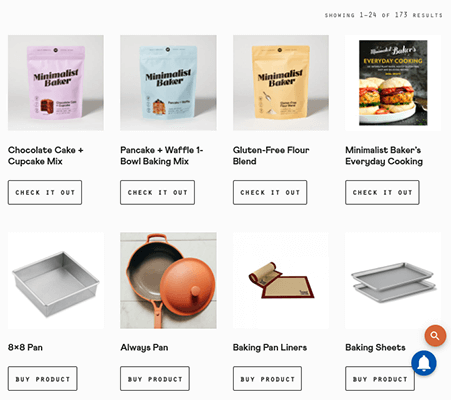
A Shop page contains products the business sells (baking mixes and cookbooks) along with affiliate links for kitchen tools and gadgets they recommend.
Their cookbook Minimalist Baker’s Everyday Cooking has a 4.7 star rating from over 2,100 reviews.
The blog used to collaborate with brands they trusted, but they stopped to ensure their audience knows they “aren’t being paid to say or promote anything.”
Social media activity
Minimalist Baker is active on Instagram, Twitter, Facebook, YouTube and Pinterest.
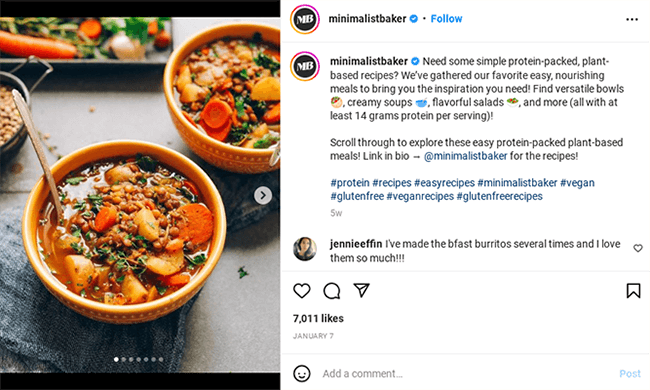
They receive most of their engagements from Instagram. They have 2.1 million followers, post photos from their latest recipes and receive a few thousand likes per post.
3. Pinch of Yum
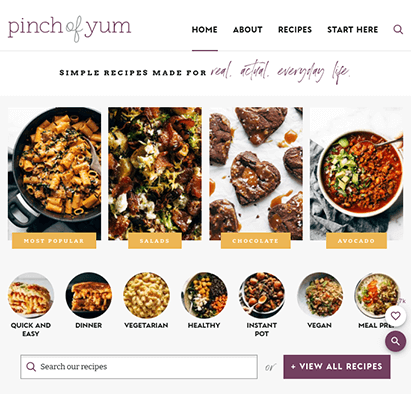
DA: 73 | Traffic: 3 million+ per month | Load Time: 1.19s | CMS: WordPress
Pinch of Yum is part food blog-part lifestyle blog. It was founded by Lindsay, the blog’s owner in 2010. She used it as a casual hobby while she worked as a 4th-grade teacher.
She’s still the blog’s writer and recipe creator, but she now works with a small team that includes her husband Bjork as technical consultant and business advisor as well as additional team members who manage the community, sponsorship deals, content marketing and video producing.
Pinch of Yum’s content now reaches millions of readers per month. It’s even been featured by CNN, Refinery29, BuzzFeed, PopSugar, Kitchn and more.
Content
Pinch of Yum publishes new content a few times per month.
You’ll find this content on two primary pages: a Blog page for all posts, including recipes, and a Recipe Index page for only recipes.
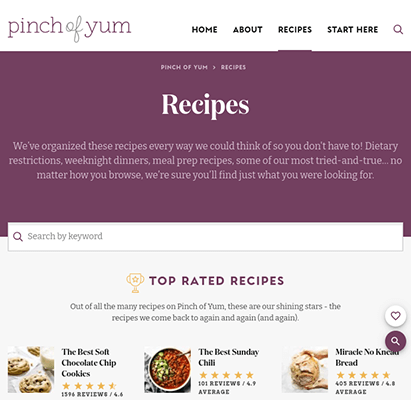
The latter page showcases the site’s latest recipes by popularity, the site’s recipe categories, course, dietary restrictions, seasons, ingredient and type, such as instant pot recipes.
As a part-lifestyle blog, Pinch of Yum also covers topics related to travel, motherhood, home design and more.
The blog’s posts have a good balance between text and images, which are shot on a Canon 6D and a variety of compatible IS lenses.
Recipe posts use recipe cards from Tasty Recipes, which was actually created and is still operated by Pinch of Yum.
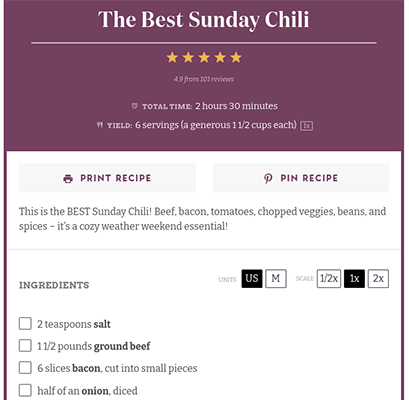
Readers can scale recipes, print them, switch between US and metric measurements, look over nutrition facts, and even check off ingredients.
Some recipe cards even include short videos for each step.
Income streams
Pinch of Yum has quite a few income streams.
Let’s start with ads, which they use AdThrive for. In fact, one of Pinch of Yum’s last income reports states that the blog made over $52,000 in November of 2016 alone from AdThrive (and over 4.2 million pageviews).
On blog post pages, the blog uses a sticky ad at the bottom of the viewport and a floating ad in the sidebar.
Affiliate marketing is also a major factor. The blog uses affiliate links for equipment on recipe pages, and they also have a few hubs for affiliate links, such as several resource pages.
Pinch of Yum also creates sponsored content by partnering with brands through blog posts and Instagram content.
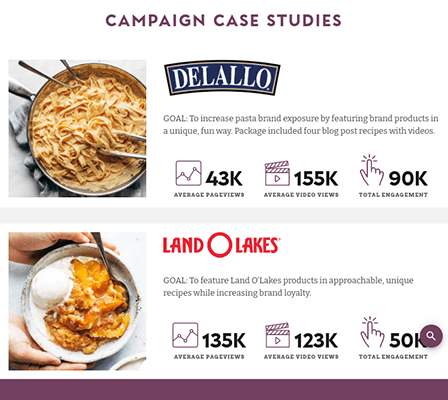
They’ve worked with Aldi, Land O’Lakes, Google, Chobani, Almond Breeze, DeLallo and more.
Lastly, Pinch of Yum has become such a successful food blog that it’s allowed Lindsay and Bjork to launch several additional brands, all under a parent company called TinyBit:
- WP Tasty – A collection of WordPress plugins for food bloggers.
- Food Blogger Pro – A membership program that guides new bloggers through the process of starting a blog and growing it.
- Clariti – A better way for WordPress users to organize blog content within WordPress. It’s designed to be an alternative to spreadsheets and project management apps.
- Nutrifox – Nutrition label plugin designed to work with Tasty Recipes.
- Curbly – A DIY community TinyBit acquired in 2021.
These brands have helped Pinch of Yum cement their place in the food and WordPress blogging industries.
Social media activity
Pinch of Yum posts their latest recipes to Instagram, Pinterest, Facebook and Twitter.
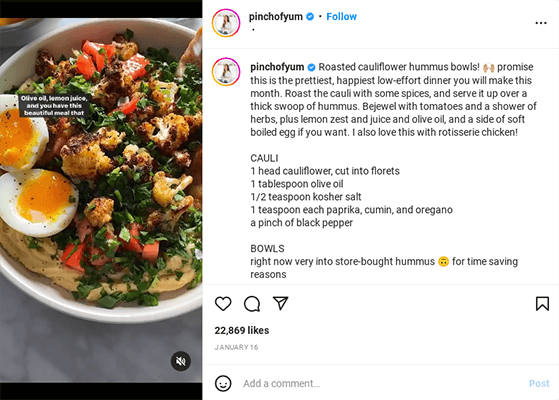
They receive a few thousand likes per post on Instagram and a few hundred on Facebook.
They have 1.1 million followers on Instagram.
4. Chocolate Covered Katie
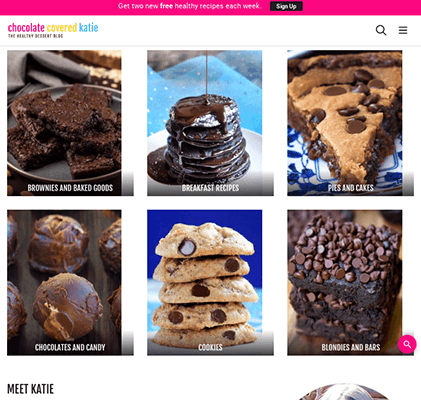
DA: 69 | Traffic: 1.9 million+ per month | Load Time: 1.78s | CMS: WordPress
Chocolate Covered Katie is a baking blog with a heavy focus on chocolate-based recipes, though it has expanded enough over the years to include other types of sweets as well as healthy recipes.
It was founded by the blog’s namesake Katie, who’s been featured by CNN, The Huffington Post, The Today Show, USA Today, Time, The Food Network, Bon Appétit, People Magazine and more.
Her cookbook was even named as one of the Top 20 Cookbooks of the year by Amazon.
Content
Chocolate Covered Katie’s primary recipe categories are Brownies, Breakfast, Pies & Cakes, Chocolate, Bars, Cookies, and Meals.
You can find an even greater breakdown of the site’s recipes on the Recipe Index page.
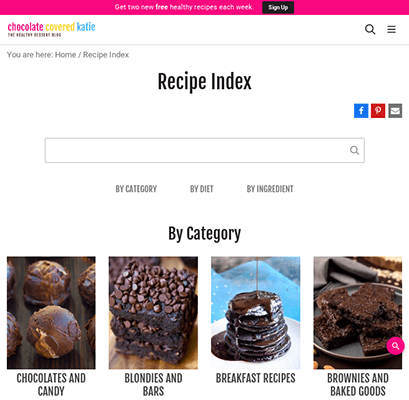
This page organizes the blog’s recipes by category, diet and ingredient.
You’ll also find list posts featuring roundups of past recipes and meal prep posts.
On recipe pages, the blog pairs a decent amount of text with large images that depict each stage.
Katie explains each step thoroughly and even provides a few different options on how to do each one, such as different crust types you can use for a pie or cheesecake.
Images are taken with a Canon 5D Mark III and a 100mm macro lens.
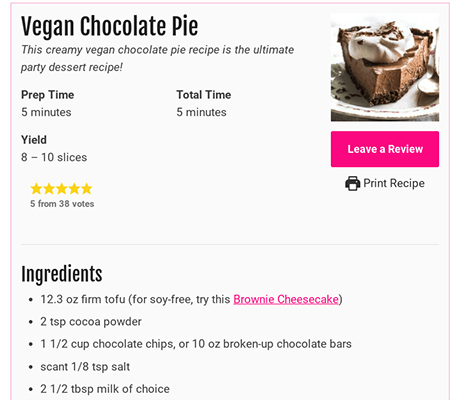
Recipes conclude with a recipe card made with WP Recipe Maker. They include a print option, reader reviews, a list of ingredients, instructions and nutrition facts.
Income streams
Chocolate Covered Katie’s income streams mainly revolve around ads and affiliate links.
The blog uses AdThrive and places ads at the bottom of the viewport and in the sidebar. There are also a few throughout the body of each post.
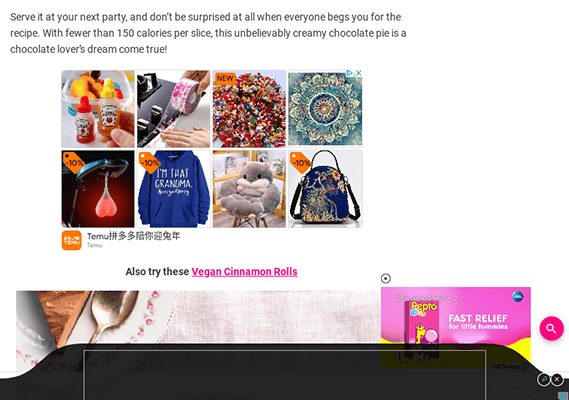
Affiliate links are typically reserved for cooking equipment, such as food processors or storage containers.
Katie also has a cookbook called Chocolate-Covered Katie: Over 80 Delicious Recipes That are Secretly Good for You. It has a 4.7 star rating out of over 580 reviews.
Social media activity
Chocolate Covered Katie is active on Instagram, Pinterest, YouTube and Facebook.
She receives most of her engagements from Instagram and Pinterest, where she has over 500,000 and over 370,000 followers respectively.
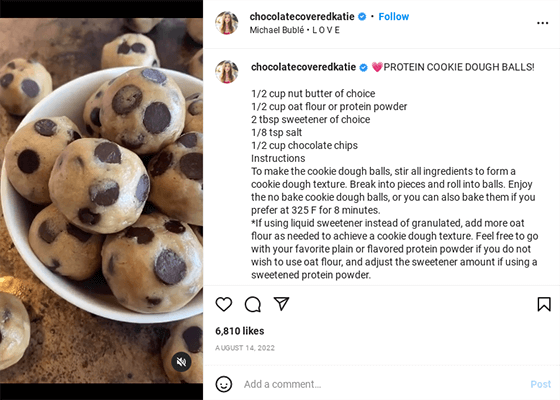
She receives a few thousand likes per post on Instagram.
5. Iowa Girl Eats
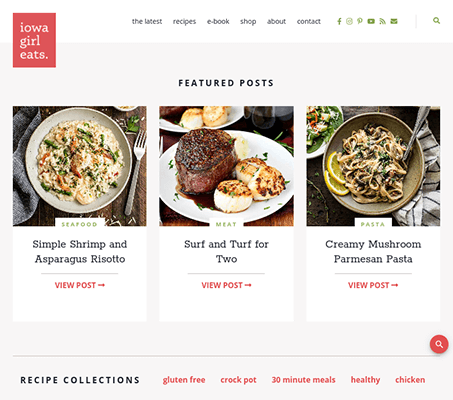
DA: 65 | Traffic: 840,000+ per month | Load Time: 955ms | CMS: WordPress
Iowa Girl Eats is a vast collection of over 600 recipes written by Iowa native Kristin, who started the blog shortly after getting married in 2008.
She published a variety of different recipes for a few years before she was diagnosed with celiac disease in 2013, six months after giving birth to her first child.
As she removed gluten from her own diet, she gradually removed it from the blog as well.
Now, Iowa Girl Eats is one of the best food blogs for gluten-free recipes. It’s been featured by Better Homes & Gardens, The Huffington Post, The Today Show, Glamour, Forbes, BuzzFeed and more.
Content
Iowa Girl Eats publishes content to a proper Blog page as well as a Recipe Index page.
Although nearly all of the blog’s recipes are gluten free, it covers a wide range of ingredients, diets and cuisines while other food blogs seem to pick a specific cooking style and stick with it.
You’ll find meat-based recipes, plant-based recipes, sides, slow cooker recipes, main courses and everything in between.
The Recipe Index page, in particular, lets you filter recipe results by ingredient, course, cooking method and diet.
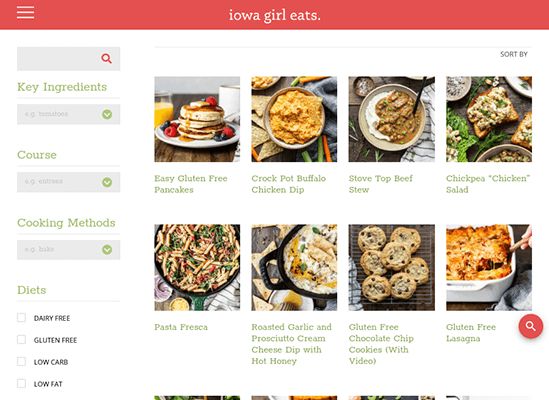
Recipe pages are lush with content. Kristin answers any questions readers may have about the recipe as she works her way through it.
And, of course, recipes are paired with large, well-shot images and an elegant recipe card.
Income streams
Iowa Girl Eats uses ads from AdThrive in the usual places: bottom of the viewport, in the sidebar and throughout the body section of blog posts.
Kristin also has an Amazon affiliate page where she recommends products in the following categories: Kids, Lifestyle, Groceries, Babies and Kitchen Favorites.
She also has an ebook called Gluten Free for Beginners.
Social media activity
Iowa Girl Eats is active on Facebook, Instagram, Pinterest and YouTube.
She receives most of her engagements from Instagram. She receives hundreds of likes per post.
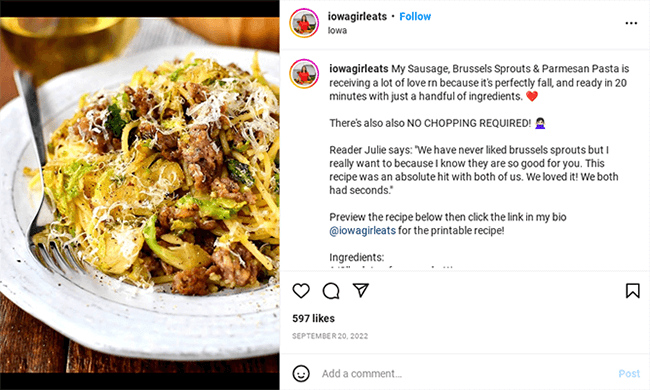
Final thoughts
That concludes our list of the most inspiring food blogs on the web.
We now know there are quite a few elements you’ll need to emulate in your own blog if you want to see the same level successful:
- Choose a niche. Specifically, a style of cooking to focus on.
- Consider using WordPress as it has dedicated food blogging themes and plugins. Again, Cook’d Pro and Foodie Pro for the Genesis theme is a fantastic choice.
- Upload often.
- Create a Recipe Index page, or at least make it easy for readers to search for recipes and filter recipe lists.
- Add a recipe card to blog posts. Tasty Recipes and WP Recipe Maker seem to be the preferred options, but Recipe Card Blocks is another great choice.
- Take your own images, even if it means using your smartphone until you can upgrade to a professional photography setup.
Monetizing a food blog
We noticed a few trends that all food blogs have in common, and that’s how they monetize their content.
Ads are the most popular choice by far. Specifically, ads from AdThrive.
AdThrive is an ad network and a popular alternative to Google AdSense. It enables you to display niche-specific ads on your website.
Affiliate marketing is another popular income stream. Use it on ingredients and equipment you mention in blog posts.
You can also set up a Shop page on your website, and fill it with affiliate products.
A Resources page is a great choice as well as it enables readers to view your most frequent recommendations in one place.
Lastly, a cookbook, whether you work with a publisher or create an ebook, is one of the best ways for food blogs to launch their own products.
You might also consider working with brands to publish sponsored content as an additional way to monetize your site. Study Pinch of Yum for tips on how to approach sponsored content.
How important is social media for food blogs?
A final trend you’ll notice about these blogs is how small of a social media influence they have, even if you combined them.
This tells us that while social media can be a powerful form of marketing for food blogs, it isn’t necessary.
What you should focus on, as far as social media is concerned, is giving your audience multiple ways to share your content on social media.
The blogs on this list use Pinterest plugins to add “pin” buttons to recipe images.
They also showcase share buttons on blog post pages and in recipe cards.
Above all else, we hoped you learned a thing or two from this post, and we wish you luck in your own blogging journey.
Finally, if you enjoyed this post, I’d recommend checking out other posts in this series:
Disclosure: This post contains affiliate links. This means we may make a small commission if you make a purchase.
